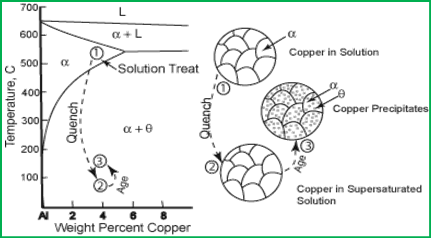Heat-treating is a term used to describe all of the controlled heating and cooling operations performed on a material in the solid state for the purpose of altering its microstructure and/or properties. The major objectives of the different kinds of thermal treatments are:
- Soften the material for improved workability. Increase the strength or hardness of the material.
- Increase the toughness or resistance to fracture of the material.
- Stabilize mechanical or physical properties against changes that might occur during exposure to service environments.
- Insure part dimensional stability.
- Relieve undesirable residual stresses induced during part fabrication.
Different metals respond to treatment at different temperatures. Each metal has a specific chemical composition, so changes in physical and structural properties take place at different and critical temperatures.

Depending on the thermal treatment used, the atomic structure and/or microstructure of a material may change due to movement of dislocations, an increase or decrease in solubility of atoms, an increase in grain size, the formation of new grains of the same or different phase, a change in the crystal structure, and others mechanisms
Precipitation Hardening:
An approach often taken to develop alloys for strength is reaching an alloy with a structure that consists of particles (which impede dislocation movement) dispersed in a ductile matrix, obtained by choosing an alloy with a single phase at elevated temperature, but on cooling will precipitate another phase in the matrix.
A thermal process is developed to produce the desired distribution of precipitate in the matrix and when the alloy is strengthened by this thermal treatment, it is called precipitation strengthening or hardening.
Precipitation hardening consists of three main steps: solution treatment, quenching, and aging.
- Solution treatment – involves heating the alloy to a temperature that allows the alloying atoms (called the solute) resulting in a homogeneous solid solution of one phase.
- Quenching – rapidly cools the material so fast and freezes the atoms that the atoms of the alloying elements do not have time to diffuse out of the solution.
- Aging – is the process where the solute particles diffuse out of the solution and into clusters that distort and strengthen the material.
The precipitation hardening process for a copper-aluminum alloy is shown graphically in the image below. The phase diagram is simply a map showing the structure of phases present, as the temperature and overall composition of the alloy are varied. The images on the right in the image show the resulting microstructure at each step in the process.

Common Heat-Treating Processes:
The more common terms used in worldwide industrial heat-treating are indicated below:
1. Age Hardening – is a relatively low-temperature heat treatment process that strengthens a material by causing the precipitation of components or phases of alloy from a super-saturated solid solution.
2. Annealing – is a softening process in which metals are heated and then allowed to cool slowly. The purpose of annealing is to soften the material for improve machinability, formability, and sometimes to control magnetic properties.
3. Normalizing – is much like annealing, but the cooling process is much faster. This result is increased strength but less ductility in the metal. Its purpose is to refine grain structure, produce more uniform mechanical properties, and sometimes to relieve internal and surface stresses.
4. Precipitation Heat-Treatment – is the three-step process of solution treating, quenching, and age hardening to increase the strength or hardness of an alloy.
5. Solution Heat-Treatment – involves heating the material to a temperature that puts all the elements in solid solution and then cooling very rapidly to freeze the atoms in place.
6. Stress Relieving – is a low-temperature heat treatment process that is used to reduce the level of residual stresses in a material.
7. Tempering – involves gently heating a hardened metal and allowing it to cool slowly will produce a metal that is still hard but also less brittle. This process is known as tempering.
8. Quenching – is the rapid cooling of a hot material. The medium used to quench the material can vary from forced air, oil, water and others. Many steels are hardened by heating and quenching. Quenching results in a metal that is very hard, but also brittle.
For more information and training for NDT, courses on NDT, welding courses we have our training institute open to all, visit us at https://aqcinspection.com/training/.









